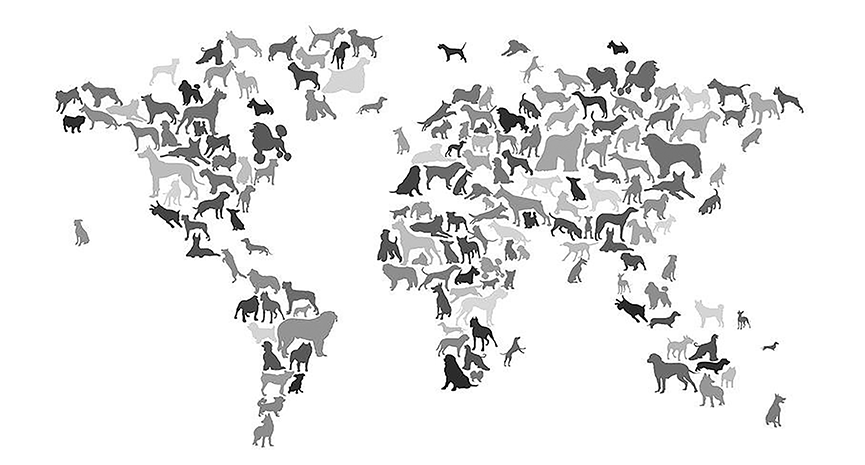How dogs live in other countries will surprise you. When traveling abroad, one of first thing you’ll notice is the abundance of dogs found in the streets of many international cities. Take a trip to India, and a US pet owner will be surprised by all of the homeless street dogs. But spend some time there and you will notice that these dogs aren’t really homeless after all. Their home is the busy streets of for instance, Delhi. Passerbys will stop to feed them, pet them and give them water. The dogs camp out on cool dirt streets under the awnings of local shops and hotels.
Visitors often end up “adopting” a dog for the duration of a visit. One story has it that at the end of a stay, food from a hotel breakfast was packed up and given to feed the dogs. Then astonishingly they wanted nothing to do with the freshly made chicken sausage because they were already full!
The whole thought makes one wonder, how are dogs treated around the world? It is a big world out there but here is a few insights on how dogs live around the rest of the globe.
In the US, Americans own over 86.4 million cats and 78.2 million dogs. The number of households that have pets tops the number that has children. In 2014, Americans spent nearly $58.5 billion on pet expenditures, according to the American Pet Products Association. That’s a big number!
Pets are welcomed into homes as family. Sometimes they go on vacations with us. They receive shelter from the cold and find their way snuggled into bed with us at night. However, in stark contrast to our compassion for our pets, Americans euthanize 2.7 million dogs and cats in shelters each year according to The Humane Society of The United States. This is in part due to some unscrupulous puppy mills, breeding/overbreeding, lack of sterilization in pets and not knowing the responsibility it takes to raise a pet. In efforts to improve the quality of life for pets, the United States is pushing sterilization programs that offer free or reduced spay and neuter opportunities for pet owners.
If you ever wondered how man’s best amigos are viewed in Latin America, well according to The Economist, things have gotten a lot better, thanks to the pet care boom happening virtually in all emerging markets. More people are bringing dogs into their lives for companions, rather than security. In fact in the past five years, spending on pet food and pet related knick-knacks has risen by 44%, to $11 billion.
Estimates are that Chile has more pet dogs per person than any other country… think about that. This is because of rising incomes and the fact that young people all over the world seem to be putting off marriage and families and replacing them with a pet! However, there is still room for improvement. The lack of proper nutrition for dogs in Latin America has caused a rise in efforts to urge owners to properly feed their pets. Interestingly many Latin American families still feed their pooches table scraps and pet superstores as we know them barely exist south of the Rio Grande.
Now a Google search of how dogs are treated in China will return not-so-nice stories and reports. A lot of controversy surrounds China in relation to its treatment of dogs and the fact that they have no animal welfare laws. But because of increased interest in animal rights groups and the push for humane treatment of dogs, three quarters of China’s population have indicated a desire for improved animal welfare protections. In addition, due to China’s growing economy, pet ownership rates have increased dramatically, and more and more families are bringing canines into their homes!Social mores can change slowly but any civilized society will ultimately demand animals are treated correctly.
As mentioned previously most of India’s dogs are street dogs. Millions of street dogs coexist with people in the center of the country’s booming cities. Not surprisingly because of this, thirty-six percent of the world’s rabies deaths occur in India. However, thanks to the Humane Society International, and a program called Capture, Neuter, Vaccinate & Return, rabies related incidents have decreased dramatically. Where there are people, there are dogs. And India’s large population have a great tolerance and often compassion for street dogs. The pooches are cared for by local communities despite that fear of rabies. The Humane Society International has helped train and educate local veterinarians on protocol in sterilization techniques that are quick, effective and safe. So for instance in Jaipur, a northern India state, human rabies cases have fallen to virtually zero.
In Islamic cultures, such as Saudi Arabia, dogs are considered “unclean.” It can be noted many Saudi nationals are often uncomfortable and afraid around animals. Only recently have attitudes started to change, with more affluent families keeping canines at home. As with any affluent society often the type of pets kept are pedigree breeds used as a symbol of status. All dogs have to be classified as a working dog, such as a guard dog or hunting dog, otherwise they cannot be kept as pets. However, Saudis are fond of cats and often play with pet the cats that roam in the streets.
Pet ownership is a luxury most commonly enjoyed by populations with funds to spare. And as countries get richer, new classes of workers, including dog walkers and pet-sitters, spring up to accommodate the wealthy and their furry friends.





